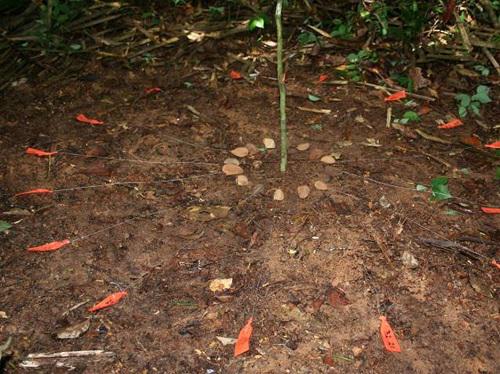Torbjørn Haugaasen
Other projects
20 Jul 2009
Nutty Livelihoods: Efforts to Save Rural Incomes and a Crucial Extractive Industry in the Amazon II
This study aims to use a combination of direct observations, field experiments and laboratory experiments to shed light on the underlying mechanisms of Brazil nut regeneration and population dynamics under natural conditions. This will test the demographic predictions outlined by Peres et al. (2003) and provide crucial information needed to produce a management plan for the sustainable harvest of Brazil nuts.

Marked seeds.
The Brazil nut tree (Bertholletia excelsa) is a long-lived and widespread emergent tree in lowland Amazonian forests and provides one of the most socio-economically important non-timber tropical forest products – the Brazil nut. However, despite its economic importance we know relatively little about the ecology and biology of this species under natural conditions and the impacts of human exploitation on population dynamics and recruitment. This project addresses a number of these questions using a combination of direct observations, field experiments and laboratory analysis.

Seed station.
Investigating the underlying mechanisms of the population dynamics will help determine the impact of exploitation on the maintenance of Brazil nut populations throughout Amazonia, and the sustainable harvest of Brazil nuts in the future. A management plan to deal with Brazil nut exploitation is sorely needed and this study will go a long way to provide the answers needed to draft such a plan and ultimately inform the sustainable harvest of Brazil nuts throughout Amazonia.
Major aims of this study therefore include:
a) Investigate in detail the current demographic status of the Uauaçú Brazil nut population.
b) Gain information to better inform landscape-level management options for the sustainable harvest of Brazil nuts.
To achieve this we will, amongst other things, gather basic demographic data such as the distribution and sizes of adult trees and seedlings, run seed dispersal experiments and carry out genetic analyses. The study will take place at Lago Uauaçú (a large crescent-shaped black-water lake) which is located in the lower Rio Purús region of central-western Brazilian Amazonia, about 350 km southwest of Manaus. The Uauaçú area presents a unique place in which to study Brazil nuts on a large scale as it contains a mosaic of natural Brazil nut stands of varying harvest histories.